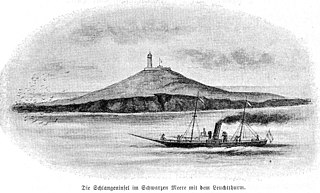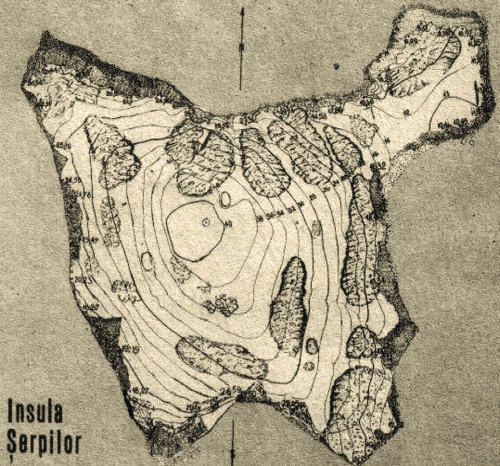
Please Follow us on Gab, Minds, Telegram, Rumble, Gab TV, Truth Social, Gettr
Guest post By K.B. Ungureanu
As the war in Ukraine rages on and the people living there suffer as their leaders stubbornly resist any rational diplomatic settlement to end the crisis, it is important to take a closer look at the idea of Ukrainian territorial integrity. As Ukrainian President Volodymyr Zelensky intransigently stated when discussing possible negotiations to end the conflict, “Our priorities in the negotiations are known. Ukraine’s sovereignty and territorial integrity are beyond doubt.” President Biden and other American political leaders have vociferously declared “the commitment of the United States to Ukraine’s sovereignty and territorial integrity.” But if we are supporting a war to defend the territorial integrity of Ukraine, we should carefully examine the basis of these claims. A tiny island in the Black Sea can help to give some historical perspective to the issue.
At the beginning of the war, on February 24, 2022, Russia seized control of Snake Island in the Black Sea. The Ukrainian propaganda machine quickly capitalized on the incident, reporting that when the Russian warships told the island’s garrison by radio to surrender, the ‘heroic’ Ukrainian defenders replied, “Russian warship, go fuck yourself.” The media reported that the defenders all died heroically defending the island, and Zelensky announced that he would posthumously award them with the nation’s highest honor, “Hero of Ukraine.” Of course, like other similar reports, such as the ‘Ghost of Kiev,’ this was nonsense. None of the Ukrainians died when Russia took control of the island.
Ukrainian nationalists like Zelinskiy have long used Snake Island as a symbol of their national sovereignty. When he held a press conference on the island in the summer of 2021, the Ukrainian president declared, “This island, like the rest of our territory, is Ukrainian land, and we will defend it with all our might.” But is there any truth to the claims of Snake Island being Ukrainian territory? To understand the real issues here, we need to look at the history of the island.
Snake Island is located 45 kilometers from the coast of Romania. Historically, it belonged to the principality of Moldavia, which united with its sister principality, Wallachia, to form modern Romania in 1859. The island is basically a small rock in the Black Sea, with a surface area of only 170,000 square meters or .17km, but it is strategically important. It has no source of fresh water or resources to allow for permanent habitation.
The Ancient Greeks and Romans called it the White Island because of white marble ruins found there. The island is first mentioned in writings from 777 B.C. According to Greek mythology, the Goddess Thetis asked Neptune, the God of the Sea, to raise an island from the sea to honor her son Achilles, the hero of Troy. The remains of Achilles and Patrocles were said to have been brought to the island by Thetis to be placed in a sanctuary. The Greeks built a large temple here to honor Achilles. The temple is mentioned by the Roman poet Ovid who was exiled to Tomis on the Black Sea Coast (modern-day Constanța in Romania).
The fifteenth-century Nuremberg chronicle affirms that the Romanians had made use of the island since ancient times, following the formation of the Romanian people after the Roman conquest of Dacia in A.D. 106. The island first became part of the Romanian state of Wallachia when Mircea the Old, prince of Wallachia, inherited the region known as Dobrogea from his father-in-law, Dobrotici, in 1389. During the fifteenth century, control of the island shifted back and forth between the Romanian principalities of Wallachia and Moldavia, coming under the rule of Stephen the Great (1457-1504), the remarkable prince of Moldavia, during the second half of the century.
The first foreign occupation of the island occurred in 1484 when it was seized by the Ottoman Empire as it aggressively expanded into the region. The Turks captured the Moldavian ports of Chilia and Cetatea Alba, and Moldavia lost its fleet. During the eighteenth and nineteenth centuries, control over the island shifted back and forth between the Ottomans and the Russian Tsars as both continued to occupy the Moldavian territory.
The modern name “Snake Island” comes from numerous water snakes that inhabited the island. A famous naval battle between Russia and the Ottoman Empire, the Battle of Fidonisi (meaning Snake Island in Greek) occurred here on July 14, 1788, ending in a Russian victory.
The Treaty of Bucharest in 1812, ending another Russo-Turkish War, was disastrous for Moldavia as Russia seized Bessarabia, almost half of the principality, situated between the Prut and Dniester rivers, along with Snake Island. The border between Russia and the Ottoman Empire was then fixed at the Chilia branch of the Danube. In 1829, the Treaty of Adrianople moved the border to the St. George branch, giving Russia effective control over the mouth of the Danube. Turkey then took back control of the region at the end of the Crimean War in 1856, regaining southern Bessarabia and Snake Island.
The Romanian War for Independence in 1877 saw Russia retake southern Bessarabia while Romania regained control of Dobrogea, the mouth of the Danube, and Snake Island. The island was bombed by the Germans when they invaded Romania during World War I, destroying the lighthouse that was later rebuilt by Romania.
The end of World War I, saw the completion of Romanian national unity, as Bessarabia along with Transylvania voted, through popular assemblies, to join Romania in 1918. The Versailles Treaty ending the war confirmed these decisions and also reaffirmed Romanian control over Snake Island. For the first time since the brief unification of the historic Romanian lands under Michael the Brave in 1600, the lands inhabited by the Romanian people were united, and the formation of modern Romania was complete.
Tragedy, however, struck in 1940 when the Soviets, who had negotiated a deal with Nazi Germany to carve up Eastern Europe between them, issued an ultimatum to Romania and seized control of Bessarabia and northern Bucovina in the eastern part of the country. What followed was genocide. In 1940, over 350,000 Romanians were deported or murdered by the Russian and Ukrainian Soviet leaders. In an effort to defend its people and reclaim its territory, Romania was compelled to join with Germany in its attack on the Soviet Union in 1941.
The Germans administered the island during World War II, but Snake Island again fell under foreign domination when it was seized by the Soviets on 28 August 1944. The Soviets also retook control over Bessarabia and northern Bucovina. They divided up the Romanian territories they occupied, rewarding the Ukrainian Soviets with the territory of northern Bucovina and southern Bessarabia, while creating a fictitious Moldavian Soviet Republic in the remaining territory. As they imposed their brutal rule over the region, the genocide continued. By 1953, almost 2.5 million Romanians had been killed or deported from these regions by the Stalinist regime.
On 4 February 1948, Romanian Prime Minister Groza ceded Snake Island to the Soviets by means of a secret protocol that was, however, never ratified by the Romanian parliament. Soviets installed a military base on the island to maintain air and sea control over the mouth of the Danube. The water snakes that gave the island its name were exterminated during the Soviet occupation. The island became more important economically after 1980 when oil and natural gas reserves were identified in the continental plates surrounding the island.
With the collapse of the Soviet Union, Snake Island, along with Bessarabia and northern Bucovina, now came under Ukrainian occupation. The government of Ukraine continued the policies of its Soviet predecessor, oppressing the Romanian population in those territories, and denying them the right to use their native language in education and other official capacities. The Ukrainian government has also continued the policy of its Soviet predecessor in falsely claiming that Romanians and Moldovans are distinct ethnic groups to try to foster division among them.
Unfortunately, for the Romanian people, a series of corrupt and inept governments have ruled the country in the post-communist era. Desperate for acceptance into NATO and to appease the West in hope of economic benefits, in 1997, the Romanian government under Emil Constantinescu signed a treaty recognizing the Ukrainian occupation of Romanian territory and ceding Snake Island to Ukraine in exchange for its demilitarization. Pressure from the United States led to the ratification of this treaty ceding Romanian territory to a foreign power, which the eminent Romanian historian Florin Constantiniu rightly referred to as a “disastrous treaty” for Romania. Many consider it an act of treason by the Romanian government.
‘NO AD’ subscription for CDM! Sign up here and support real investigative journalism and help save the republic!‘
The appeasement policies by leaders in Bucharest did not end Ukrainian aggression against Romania. Ukraine tried to pretend the Island was inhabited to extend its territorial water rights to 20km around the island in an effort to deny Romania access to natural resources. Fortunately, the International Court of Justice intervened in 2009, allowing Ukraine only a 12-mile limit around the island, which the court declared to be a rock in the sea, instead of an inhabited island as Ukraine falsely claimed. Still, the damage to Romanian interests because of the government’s appeasement policy with Ukraine was significant.
The history of Snake Island and that of the Romanian territories occupied by Ukraine demonstrates the difficulty of taking claims of Ukrainian territorial integrity seriously. Ukraine is made up of many lands taken from other nations in the illegal Soviet annexations during World War II. For Ukraine to be able to rightfully ask for other nations to respect its territorial integrity, it should first have worked with its neighbors to restore those territories it had illegally acquired as an heir to the Soviet regime. In addition, its treatment of minority populations, particularly the Romanian minority in the occupied territories, does not lend any justification to claims by Ukrainian leaders of being adherents of democracy. In the end, the absurdity of the international media fawning over the ‘heroic defense’ of Snake Island reveals itself as nothing more than praising two imperialist powers, Russia and Ukraine, for fighting to control Romanian territory over which neither has a legitimate claim.
K.B. Ungureanu is a senior researcher at the Center for Romanian Studies, an independent academic and cultural institute based in Palm Beach, Florida, with the mission to promote knowledge of the history, literature, and culture of Romania in the world.
- CDM Founder L Todd Wood Appears On Tucker Carlson Tonight To Discuss Arms Trafficking In Ukraine
- One Year Later – Reflections On The Afghanistan Disaster And US Military And Political Leadership




9 comments
Quote from the article: “The end of World War I, saw the completion of Romanian national unity, as Bessarabia along with Transylvania voted, through popular assemblies, to join Romania in 1918.”
The above stastement is historially UNCORRECT and it reflects either a lack of knowledge of real historical facts or deliberate distortion of those facts. Transylvania belonged to the historical Hungarian Kingdom for 0ver 1,000 years. Transylvania was forcefully given to Romania the historical Hungarian Kingdom was chopped up creating the succession states of Yugoslavia, Romania and Czehoslovakia after WW2 buy the antant (US/UK/FRance) powers. This took place in the 1920 Trianon EDICT because Hungary was a looser in WW2 and Romania was a winner – it has to be added here that at first Romania was on the side of the axis powers (Germany an its allies) but when they saw that Germany was loosing Romania suddenly changed side so they took advantage of the situation as winners.
The above are historical facts
The article is correct in its assertions as any educated person would know. Of course, Hungarian propagandists create their own mythology to justify their political objectives and their brutal oppression of the Romanian majority during their occupation of Transylvania.
Transylvania was occupied by the Asian invaders (called Hungarians) with the help of other nationalities/tribes, but they were never able to entirely occupy it. The Romanians have always been the majority of the population, as Transylvania belonged to the old Dacia. When the oppressive Austro-Hungarian Empire lost the war in 1918, all the peoples enslaved by that prison of nations regained their freedom. If England, France, or any other former empire tried to claim its former colonies, it would be a scandal. The time of empires is gone, but only Hungary still pretends to be one again.
S.V.O.: your article is pure proaganda and historical lies. Transylvania never belonged to Romania before 1920, it belonged to the 1000-year old Hungarian Kingdom. The proof is tpday the millions of Hungarians still living in Transylvania. Before 1920 Romania, as we know it today never existed. It had the separate principalities of Wallachia, Moldavia, Bessarabia and Dobruja. These were over the centuries individual principalities with their own rulers who desperately manuevered between Hungary, the Ottoman Empire and Russia. So, to claim that Romania existed as a unified country before 1920 is lunatic at worst and lack of knowledge of historical fact at best. It was Romania’s questionable practice of regularly backstabbing its allies over the history, one of the most recent ones was backstabbing their allies, the Germans. So, whoever trust the Romanians as an ally makes a big mistake and need to learn from history.
@ Lying Hungarian troll
You people spread your lies all over the internet. Transylvania has always been Romanian with a majority Romanian population, and oppressor Asian invader Hungary will never occupy it again. Orban’s trolls are shilling for Putin and Trump and masquerading as “Americans” or other “Westerners” to fool the West into believing your lies. Nazi Orban and his corrupt Hungary are the laughing stock of the world.
Indeed, Romania as an ally is worse than an active enemy, sort of like Italy. they have documented time and again to be totally unreliable and even treasonous. This was demonstrated during WW2 when they rather than fight, ran like rabbits, exposing the flanks of Stalingrad, enabling the Soviets to literally walk in. Later they abandoned their positions without even letting their German allies know, they simply vacated entire sections of the front lines, enabling the Sovierts to march right in. As far as Transylvania goes, after the Turkish occupation and rape of that area, it was totally devoid of people until being resettled by Germans who had been recruited by Hungary. Those Germans built a flowering geographical area with lovely towns, villages and farms. The entire area was rebuilt by Germans who were driven out by the Soviet advance at a terrible cost. Every town of any consequence was built by Germans as the archtitecture proves, not to forget old maps.
if history matters
forbiddendfile.blogspot.com
historiesresearches.blogspot.com
Hungarian lies spread by Hungarians masquerading as Westerners. You mongols are pathetic.
No wonder Russia is about to implode again, it’s ideologists won’t let go of all the falsehoods that they keep perpetrating on the parts of the world that have a free press.